
The Converting Sea: How Religious Change Shaped the Early Modern Mediterranean
"Uncover the dynamic interplay of faith, culture, and power in the Mediterranean, revealing a history of conversion that goes far beyond individual beliefs."
The early modern Mediterranean was a melting pot of empires and faiths, where the movement of people and ideas across borders sparked continuous cultural renegotiations. Conversion, often viewed as a simple change of faith, was a much more complex phenomenon deeply entwined with religious change, acculturation, and cross-cultural interaction. Traditional studies have often overlooked these intricate connections, resulting in an incomplete understanding of conversion's significance in Mediterranean society.
This article broadens the understanding of conversion by examining its impact across various cultural fronts, demonstrating that it encompassed more than just switching religions. Conversion is reframed as a uniquely human ability to adapt, instigate societal change, and respond to evolving circumstances. This broader definition allows for a more comprehensive synthesis of religious changes and cross-cultural interactions that occurred in diverse areas such as literary culture, intellectual traditions, and the visual arts.
By exploring conversion in the early modern Mediterranean as a fundamental sociocultural shift, we can view the region as a "converting sea." This sea shaped the lives of its inhabitants, who, in turn, molded the cultural landscape of the Middle Sea itself. This perspective highlights the dynamic interplay between religious, political, and cultural forces that defined the era.
How Did Traditional Historiography Frame Conversion in the Mediterranean?

To fully grasp the implications of conversion, it's essential to recognize that all forms of conversion took place within a complex web of imperial expansion and the construction of competing religious, cultural, and political identities. Individual and collective changes in religious identity were invariably connected to institutional efforts aimed at integrating devotion and political loyalty. Venice, for example, established houses for catechumens to integrate converts through patronage networks and surrogate kinship.
- Recognize that all forms of conversion took place within a complex web of imperial expansion and the construction of competing religious, cultural, and political identities.
- Individual and collective changes in religious identity were invariably connected to institutional efforts aimed at integrating devotion and political loyalty.
- The Iberian empires also sought to create ethno-religiously homogenous states, intertwining religious orthodoxy and political loyalty in the edification of converts.
A Sea of Transformation
This exploration of conversion in the early modern Mediterranean demonstrates that it was a process far more complex than individual or collective religious decisions. By connecting various historiographical strands, this article highlights conversion as a means of confronting religious change and cross-cultural interaction. This allows for a better understanding of the early modern Mediterranean as a dynamic space of cultural production, characterized by the creation and reshaping of religious, political, and cultural identities. Religious conversion fostered pervasive anxiety about collaboration versus confrontation, revealing the contradictory nature of phenomena such as Christian Kabbalah and Spanish anti-Morisco policies. Conversion, therefore, emerges as a multifaceted cultural problem, influencing individual beliefs, interactions, collective identities, and artistic expression.
